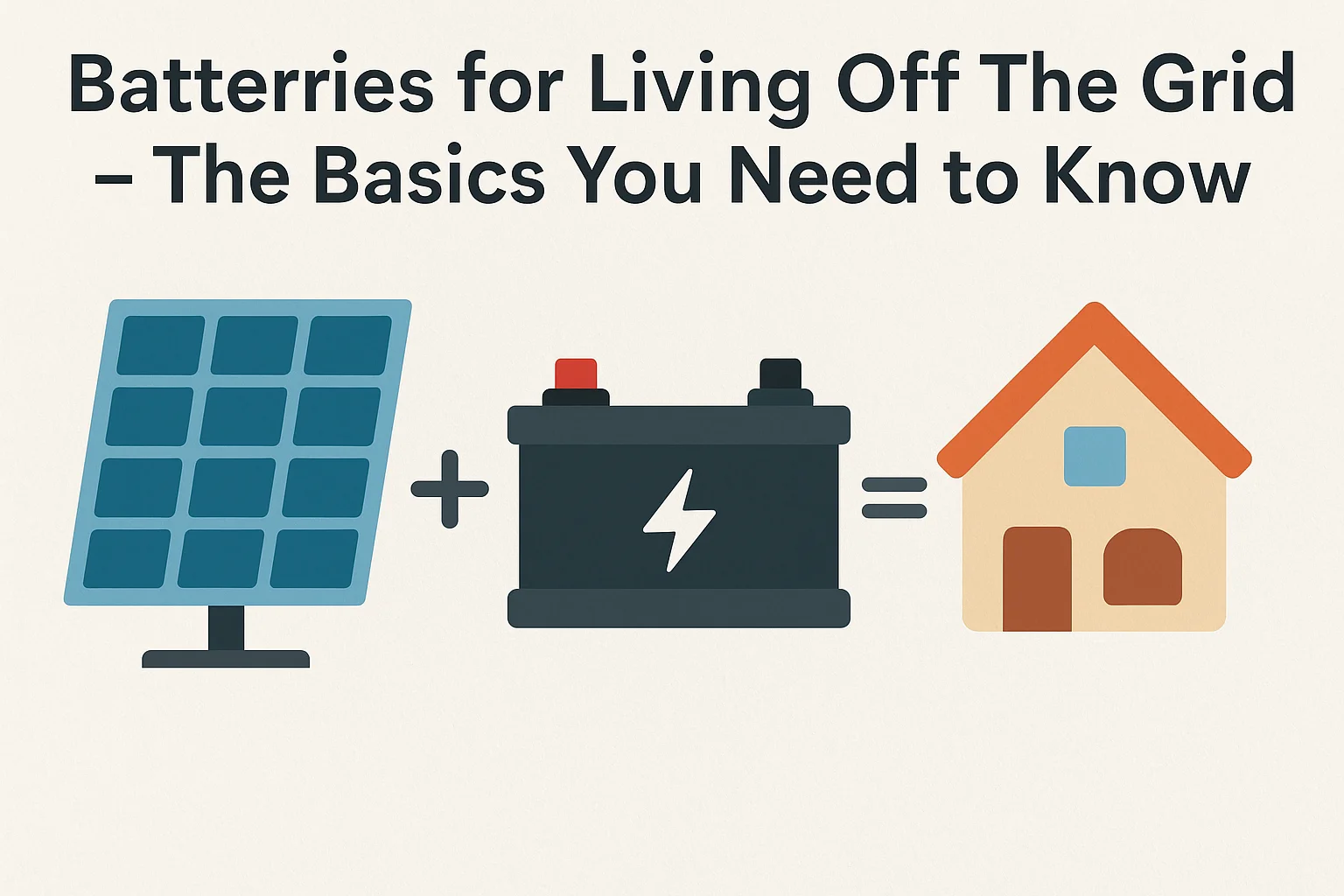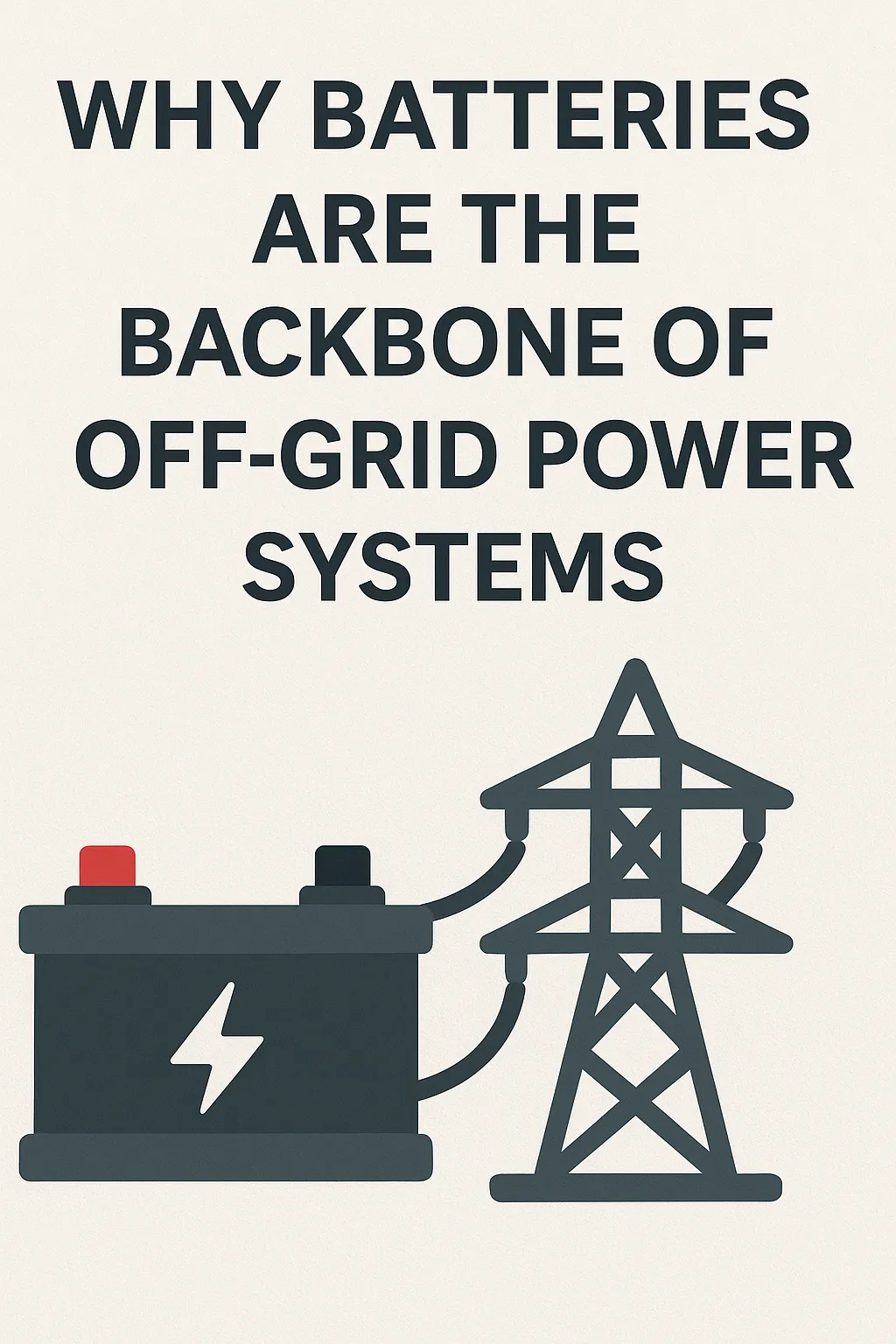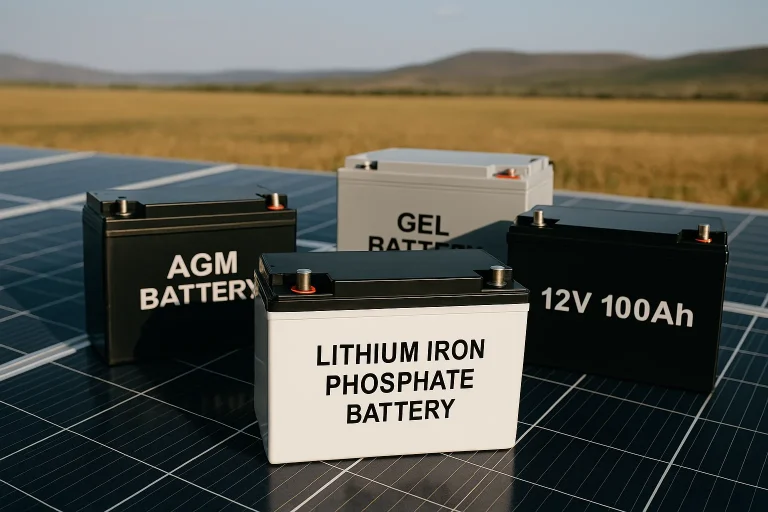Why Mastering Off Grid Battery Basics Is Key to Energy Independence
When you commit to living off the grid, your success depends on understanding one critical system: your battery bank. Without a deep grasp of off grid battery basics, you risk running out of power, damaging expensive equipment, or building a system that doesn’t meet your needs.

Whether you’re just beginning your off-grid journey or fine-tuning your existing setup, mastering these basics gives you control over your energy, budget, and long-term security.
Why Off Grid Battery Basics Are the Foundation of Your Power System
Off-grid living means you generate and store your own energy. But generating power is only half the equation. Off grid battery basics teach you how to properly store that energy and make it available when the sun isn’t shining or the wind isn’t blowing.

With a reliable battery system, you:
-
Store power for use 24/7
-
Keep appliances running even at night
-
Gain peace of mind during cloudy or stormy days
-
Maintain full independence from public utilities
Types of Batteries You Should Know for Off-Grid Living
Understanding off grid battery basics starts with choosing the right battery type. Each option has pros and cons, depending on your budget, climate, and energy use.
🔋 1. Lead-Acid Batteries (Flooded & AGM)
-
Budget-friendly but require maintenance
-
Lower cycle life and efficiency
-
Common choice for beginners
🔋 2. Lithium-Ion Batteries
-
Long lifespan, fast charging, low maintenance
-
High upfront cost
-
Excellent for full-time off-grid homes
🔋 3. Saltwater Batteries
-
Environmentally safe, no heavy metals
-
Newer technology with moderate capacity
-
Ideal for eco-conscious users
⚖️ Off Grid Battery Comparison Table
| Battery Type | Lifespan | Cost | Maintenance | Efficiency | Best Use Case |
|---|---|---|---|---|---|
| Flooded Lead-Acid | 3–5 years | Low | High | Moderate | Budget or backup systems |
| AGM | 4–7 years | Medium | Low | Moderate | Tiny homes, starter systems |
| Lithium-Ion | 10–15 yrs | High | Very Low | High | Full-time off-grid setups |
| Saltwater | 7–10 years | High | Low | Moderate | Eco-friendly energy systems |
How to Size Your Battery Bank (Using Off Grid Battery Basics)
Proper sizing is critical. If your system is too small, you’ll run out of energy. Too large, and you waste money on capacity you don’t use.
🔧 Key steps in off grid battery sizing:
-
Add up your daily energy use (in watt-hours)
-
Choose days of autonomy (usually 2–4)
-
Factor in depth of discharge (DoD) for your battery type
-
Oversize slightly for seasonal and long-term degradation
Understanding these off grid battery basics ensures you design a system that meets your actual energy needs—day in and day out.
How to Charge and Maintain Off Grid Batteries Properly
Knowing how to charge and care for your batteries is part of the core off grid battery basics. Batteries are a long-term investment, and how you treat them determines how long they’ll last.
⚡ Charging Options:
-
Solar panels (most common)
-
Wind turbines
-
Hydro systems
-
Backup generators
🧰 Maintenance Tips:
-
Clean and tighten battery terminals
-
Monitor voltage and charge cycles
-
Equalize flooded batteries monthly
-
Store batteries in a ventilated, temperature-stable room
💡 Tip: Even with proper charging, battery banks need a backup. The Lost Generator is the ideal power safety net for off-grid systems. It’s efficient, quiet, and keeps your system running in emergencies.
Safety Tips: Off Grid Battery Basics You Can’t Skip
-
Use a Battery Management System (BMS) for lithium setups
-
Fuse all power lines between battery and inverter/controller
-
Wear gloves and safety goggles for lead-acid handling
-
Never mix old and new batteries in the same bank
-
Avoid full discharges—especially with lead-acid types
Safety is a non-negotiable part of any guide on off grid battery basics.
Sample Off Grid Battery Setups for Different Homes
🏕️ Tiny Cabin Setup
-
2 AGM batteries
-
600W solar panels
-
Small inverter + charge controller
🏡 Homestead Setup
-
8–12 lithium-ion batteries
-
5 kW solar array
-
Hybrid inverter + generator backup
🛠️ Remote Workshop Setup
-
4 AGM or 3 lithium batteries
-
2 kW solar
-
Battery monitor + surge protection
📊 Quick Setup Comparison
| Setup Type | Daily Energy Use | Battery Type | # of Batteries | Backup Option |
|---|---|---|---|---|
| Tiny Cabin | 1–2 kWh | AGM | 2–4 | Manual Generator |
| Homestead | 5–8 kWh | Lithium-Ion | 8–12 | The Lost Generator |
| Remote Workshop | 2–4 kWh | AGM or Lithium | 3–5 | Solar + Manual Reset |
Costs to Expect When Starting with Off Grid Battery Basics
| Component | Average Cost |
|---|---|
| AGM Battery (100Ah) | $150–$300 each |
| Lithium-Ion Battery | $600–$1,200 each |
| Inverter | $300–$1,000 |
| Solar Charge Controller | $100–$500 |
| Battery Monitor | $75–$250 |
Your battery bank is the biggest investment in your off-grid energy system. That’s why understanding off grid battery basics helps you make smarter, more sustainable decisions.
Common Mistakes to Avoid in Off Grid Battery Basics
-
❌ Choosing the wrong battery chemistry for your needs
-
❌ Undersizing your system
-
❌ Forgetting seasonal energy fluctuations
-
❌ Not budgeting for battery replacements
-
❌ Skipping maintenance or protective gear
Avoiding these pitfalls is one of the most important lessons in off grid battery basics.
Recommended Backup: The Lost Generator
Even the best battery systems need a lifeline. The Lost Generator is that lifeline. It’s efficient, portable, and built for off-grid life.
Use it to:
-
Charge your batteries during low-sun weeks
-
Power essential devices in emergencies
-
Keep fridges, lights, and security systems online
FAQ – Off Grid Battery Basics
What are off grid battery basics everyone should know?
Battery type, sizing, charging, safety, and maintenance are foundational.
Do I need a generator if I have a battery bank?
Yes—especially for cloudy seasons. The Lost Generator is a top backup choice.
Can I mix battery types in my system?
No. Always use identical batteries for safety and performance.
What’s the best battery type for beginners?
AGM batteries are simple and affordable—a solid starting point.
How do I know if my batteries are sized correctly?
Compare your daily energy use to your bank’s total watt-hour capacity.
Conclusion: Off Grid Battery Basics Empower Your Energy Freedom
Learning off grid battery basics isn’t optional—it’s essential. Your battery system determines whether your fridge runs, your tools charge, and your family stays safe.
👉 Start by tracking your energy use, choosing the right battery type, and building a bank that fits your lifestyle.
Don’t forget a backup like Ultimate OFF-GRID Generator—because even the best systems need a plan B.

